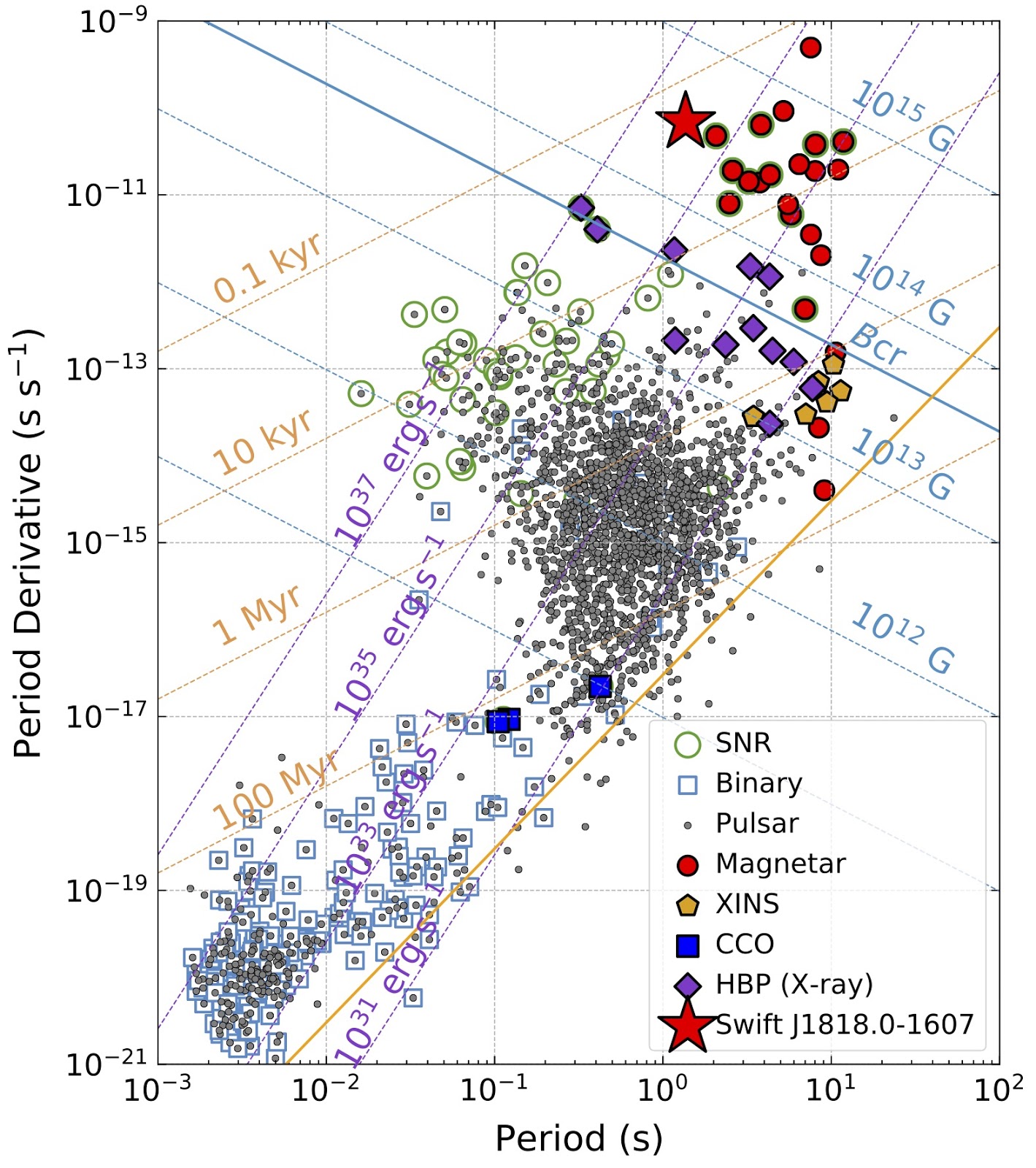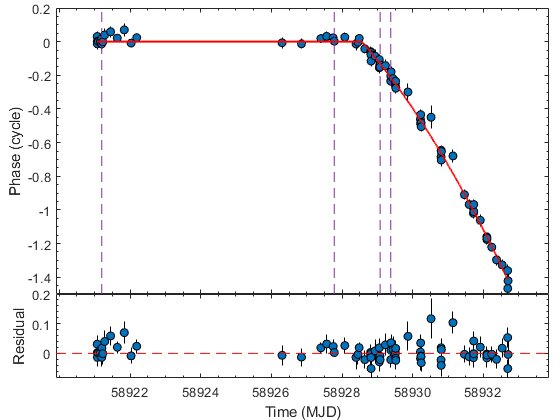NICER / ISS Science Nugget
for March 26, 2020
A new magnetar, Swift J1818.0-1607, offers clues to neutron star
evolution
At 21:16:47 UT on March 12, a gamma-ray burst from the Galactic plane
was detected with the Burst Alert Telescope (BAT) onboard the Neil
Gehrels Swift Observatory, which was originally designed to observe
gamma-ray bursts from cosmological distances. Spectral and timing
behaviors of this event were different from those of cosmological
gamma-ray bursts, and more similar to short bursts emitted from
magnetars, which are a subclass of neutron stars exhibiting the
strongest known magnetic fields.
Four hours after the first alert from the Swift team (GCN circular #27373), NICER started follow-up
observations of this target. In the first data downlinked from ISS, the
NICER team discovered that this source pulsates with a period of 1.36
sec (Figure 1). This period is similar to but shorter than the rotation
periods of most magnetars, which are in the range 2-11 seconds. This
pulse detection, additional evidence of a new magnetar, was reported to
the astronomical community (Astronomer's Telegram #13551).

Figure 1:
NICER X-ray pulse profile of Swift J1818.0-1607 in the 2-8 keV band. For clarity,
two cycles of the 1.36-sec period are plotted.
This new magnetar, Swift J1818.0-1607, is becoming important for
astronomers to study the diversity of neutron stars because its
characteristics draw from both magnetars and rotation-powered pulsars,
which had been historically recognized as different subclasses of
neutron stars. Subsequent NICER monitoring between March 13 and 24
revealed that the neutron star's rotation is gradually slowing down
(Astronomer's
Telegram #13588).
Using the stellar rotation period and
its time-derivative, astronomers can derive approximate values for the
star's magnetic field strength, age, and rotational energy loss
(spin-down luminosity). The magnetic field of Swift J1818.0-1607 is
typical of known magnetars (6.1x1010 Tesla), whereas the estimated age
was revealed to be very young (of order 300 years!). The spin-down
luminosity is the highest among magnetars, and rather close to those of
young rotation-powered pulsars. Thus, Swift J1818.0-1607 appears to lie
between the two categories (Figure 2).

Figure 2:
The distribution of known pulsars (neutron stars) is shown in the space of their
stellar rotation periods and period derivatives. The rotation of isolated neutron
stars gradually slows down by radiating electromagnetic waves and outward particle
winds. Estimate pulsar age, magnetic field strength, and rotational energy loss are
displayed in yellow, blue, and purple dashed lines, based on standard spin-down
assumptions. Different pulsar species are indicated by different symbols (see the
legend), with magnetars located in the region of the highest magnetic field strength
(upper right corner). The newly-discovered magnetar, Swift J1818.0-1607, is shown
with a star symbol. The original figure is credited to Enoto, Kisaka, and Shibata
(2019).
This conclusion was further supported by multi-wavelength follow-up.
NICER's discovery of the 1.36-sec pulsation encouraged monitoring
campaigns not only by X-ray satellites, but also by many ground-based
radio telescopes, which have reported detections of radio pulses from
Swift J1818.0-1607. Most magnetars are radio-quiet, while
rotation-powered pulsars usually show radio pulses. The radio detection
again suggests a combination of properties of magnetars and
rotation-powered pulsars.
The NICER team continues its monitoring campaign and is coordinating
simultaneous coverage with radio observatories. During the NICER
observations, several short bursts were observed. Some of them may be
associated with a timing anomaly in the pulsar spin evolution, namely a
pulsar glitch (Figure 3). During the bursting activity, the star's
magnetosphere might undergo a rearrangement of its magnetic field, in
turn provoking a change in torque on the star and thus on its rotation
(Astronomer's
Telegram #13588).

Figure 3:
Residuals of the pulsar spin ephemeris of Swift J1818.0-1607. The dashed vertical
lines show a timing anomaly around these short bursts. (Astronomer's Telegram #13588)
The NICER team will keep a close eye on this mysterious new Galactic
source.
<< Previous
Main Index
Next >>